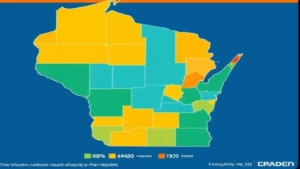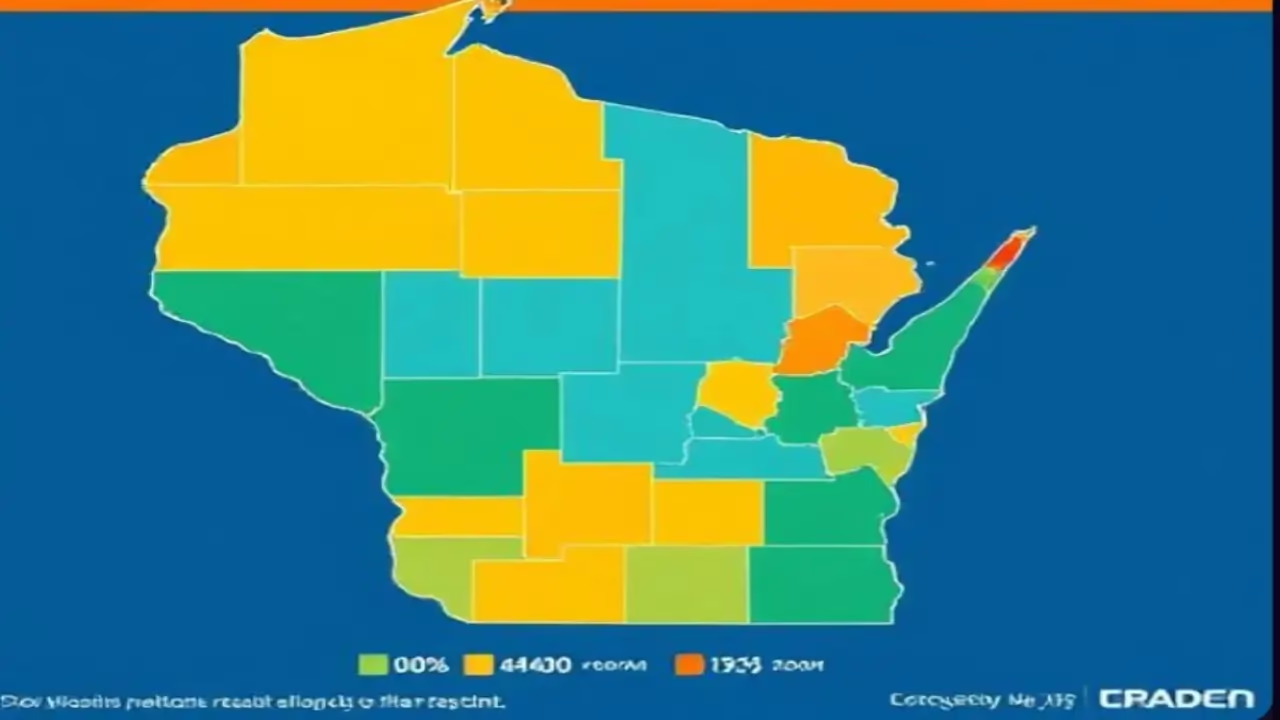Wisconsin Election Results: What You Need to Know
Meta Description:
Explore comprehensive insights into Wisconsin election results in our step-by-step guide. Learn about historical trends, voter demographics, key issues, and future predictions to make informed decisions.
Wisconsin Election Results: What You Need to Know
Imagine being able to understand how the results of an election shape not only local governance but also national policies—especially in a swing state like Wisconsin. Many voters, students, and political enthusiasts often face questions about the significance and trends behind wisconsin election results. Are the changes in voter turnout reflecting shifting demographics? How do key issues impact the final results? In this comprehensive guide, we delve into the world of Wisconsin election results, providing a clear, step-by-step analysis that is both informative and accessible. Whether you are trying to decide on your vote, analyze trends for a research project, or simply want to understand how elections work, this article is crafted in simple human English to help you solve your questions and gain deeper insights.

For more expert insights on technology and digital trends, check out Aixplore Tech.
1. Understanding the Importance of Wisconsin Election Results
Wisconsin has long been a politically significant state in the United States. Its election results often influence the balance of power at the national level, making it a key battleground in presidential and congressional races.
- Political Influence: Wisconsin’s voting patterns can sway national policy decisions.
- Economic Impact: Election outcomes can affect state-level economic policies that impact local businesses and communities.
- Social Relevance: The results reflect the evolving concerns of its diverse population, including healthcare, education, and employment.
This section introduces the critical role that Wisconsin election results play, not just for local governance, but for the country as a whole.
2. Historical Overview of Wisconsin Election Results
2.1 A Look Back at the Past
Wisconsin’s electoral history is filled with interesting shifts and trends. Over the decades, the state has seen significant changes in voter behavior and political alignment.
- Early Trends: In the mid-20th century, Wisconsin was known for its progressive politics and high voter participation.
- Recent Shifts: In the last few decades, the state has experienced a swing between major political parties, reflecting broader national trends.
Historical data from sources like CNN Politics reveals that changes in demographics and economic conditions have continually reshaped the political landscape.
2.2 Milestones in Wisconsin Elections
Key milestones include landmark elections that have set precedents and influenced policy shifts. Analyzing these milestones helps understand the trajectory of wisconsin election results.
- 1960s to 1980s: A period of robust political engagement and progressive reforms.
- 1990s Onwards: Increased polarization and the rise of digital campaigning.
- Recent Elections: Marked by high voter turnout and the influence of social media, which have dramatically impacted campaign strategies.
These historical perspectives provide a foundation for understanding the current state of Wisconsin’s political dynamics.
3. Analysis of Recent Wisconsin Election Results
3.1 Overview of the Latest Election Cycle
The most recent election cycle in Wisconsin has drawn significant attention due to its high stakes and competitive nature. Key factors included voter mobilization efforts, major policy debates, and the influence of national politics.
- Voter Turnout: Recent elections have seen record-breaking voter participation.
- Close Contests: Many races were decided by narrow margins, highlighting the importance of every vote.
- Key Winners: Analysis of which political parties and candidates gained the most support.
Recent statistics from Reuters indicate that the voter turnout and engagement in Wisconsin have been among the highest in the nation.
3.2 Key Factors Driving the Results
Understanding the drivers behind the latest wisconsin election results involves examining several critical areas:
- Economic Concerns: Issues like job creation, taxation, and public services were at the forefront.
- Social Issues: Debates on healthcare, education, and civil rights played a significant role.
- Political Campaigning: The effectiveness of digital campaigns and grassroots mobilization efforts.
By analyzing these factors, you gain a clearer picture of why voters made the choices they did.
4. Voter Demographics and Behavior
4.1 Demographic Shifts
One of the most important aspects of wisconsin election results is the changing demographic landscape. Understanding who is voting and why is crucial for analyzing election outcomes.
- Age Groups: Younger voters are increasingly participating, impacting policy priorities.
- Ethnic Diversity: Shifts in the ethnic composition of the electorate are influencing voting patterns.
- Urban vs. Rural: Differences between urban centers and rural areas highlight varying priorities and political leanings.
Data from the U.S. Census Bureau () supports these observations, showing how demographic shifts contribute to evolving political trends.
4.2 Voter Behavior Patterns
Analyzing voter behavior helps explain the dynamics behind wisconsin election results. Consider the following:
- Issue-Based Voting: Voters are increasingly influenced by specific policy issues rather than party loyalty.
- Turnout Variations: Factors such as weather, local events, and campaign strategies can significantly impact turnout.
- Digital Influence: Social media and online platforms are playing a larger role in shaping opinions and mobilizing voters.
Understanding these patterns is essential for predicting future election outcomes and planning effective campaigns.
5. Impact of Wisconsin Election Results on Local Politics
5.1 Policy Changes and Governance
The outcomes of Wisconsin elections have a direct impact on state policies and local governance. Changes in leadership can lead to:
- New Legislative Agendas: Implementation of policies on education, healthcare, and infrastructure.
- Budget Allocations: Shifts in how state funds are distributed among various programs.
- Regulatory Reforms: Changes in state regulations that can affect businesses and communities.
These policy changes not only affect the local population but also set the tone for the region’s economic and social development.
5.2 Community Engagement
Local election results often reflect the engagement of communities with their government. High voter participation can lead to more responsive governance and better representation of public interests.
For further details on local political impacts, refer to articles on The New York Times Politics .
6. Influence on National Politics
6.1 Wisconsin as a Swing State
Wisconsin is often considered a swing state, meaning that its election results can significantly influence national outcomes. The way voters in Wisconsin decide their elections can affect:
- Presidential Elections: The state’s electoral votes are highly contested.
- Congressional Representation: Shifts in voter sentiment can lead to changes in the balance of power in Congress.
- National Policy: Trends in Wisconsin often reflect broader national issues.
The significance of Wisconsin in national politics is well-documented by sources such as Politico , which emphasize its strategic importance.
6.2 Trends Affecting National Discourse
The issues that resonate in Wisconsin often mirror national debates, such as economic inequality, healthcare reform, and climate change. Analyzing these trends can provide insights into the national political landscape.
7. Digital Campaigning and Media Influence
7.1 Role of Social Media
Digital platforms have transformed how elections are conducted. Social media plays a vital role in shaping wisconsin election results by:
- Mobilizing Voters: Campaigns use social media to reach younger audiences.
- Disseminating Information: Voters receive real-time updates and news.
- Engaging with Candidates: Direct communication channels between voters and politicians.
7.2 Traditional vs. Digital Media
While traditional media like newspapers and TV still hold sway, digital media is increasingly influential. The integration of both ensures a broader reach and more diverse information sources.
For more insights into the impact of digital campaigning, explore CNN Politics .
8. Tools and Technologies for Tracking Election Results
8.1 Real-Time Dashboards
Tools like real-time dashboards are essential for monitoring wisconsin election results. These platforms provide:
- Live Updates: Continuous updates on vote counts.
- Visual Analytics: Graphs and charts that help interpret data.
- User-Friendly Interfaces: Easy-to-understand visuals for all users.
8.2 Mobile Applications
Mobile apps make it easier for voters and analysts to track election outcomes on the go. They provide notifications, detailed breakdowns, and interactive maps that display current results.
8.3 Data Sources and Research
Reliable data sources are critical for accurate analysis. Use reputable sites like Reuters and Associated Press to verify the latest figures and trends.
9. Analyzing the Impact of Wisconsin Election Results
9.1 Economic Impact
The results of elections in Wisconsin can have significant economic repercussions, influencing local business climates, investment trends, and job creation. Understanding these impacts helps investors and businesses make strategic decisions.
9.2 Social and Cultural Impact
Election results also shape social policies and community development. Changes in leadership can lead to reforms in education, healthcare, and public services that directly affect residents’ quality of life.
9.3 Future Projections
By analyzing historical data and current trends, experts make predictions about future election outcomes. These projections help voters and political analysts understand potential shifts in policy and governance.
For further reading on the economic and social impacts of elections, visit Brookings Institution .
10. Challenges in Reporting Wisconsin Election Results
Despite technological advancements, several challenges persist in accurately reporting election results.
10.1 Data Accuracy and Verification
- Multiple Sources: Conflicting data from different sources can create confusion.
- Verification Processes: Ensuring the data is accurate requires robust verification systems.
10.2 Timeliness of Updates
- Real-Time Reporting: Delays in data processing can affect the accuracy of live results.
- Infrastructure Issues: In some regions, technological limitations can hinder fast updates.
10.3 Political Bias and Misinformation
- Objective Reporting: Ensuring that information is presented objectively is crucial.
- Combatting Misinformation: Platforms must work to verify and correct false data quickly.
Addressing these challenges is vital for maintaining public trust in the electoral process.
11. Best Practices for Indexing and SEO in Election Reporting
For websites that report on wisconsin election results, effective SEO and indexing strategies are crucial to ensure that content reaches the intended audience.
11.1 Optimize Content Structure
- Clear Headings: Use descriptive headings that incorporate keywords.
- Short Paragraphs: Keep content concise and easy to read.
- Meta Tags: Ensure meta descriptions and titles include the main keywords.
11.2 Use Reliable Data Sources
- High-Authority Links: Cite reputable sources like Reuters, CNN, and Politico to enhance credibility.
11.3 Regular Updates and Refreshes
- Timely Content: Regularly update articles to reflect the most current election results.
- Engage Readers: Encourage comments and discussions to signal content relevance.
For more detailed SEO strategies, check out Moz’s SEO Best Practices .
12. Frequently Asked Questions (FAQ)
Q1: What are Wisconsin election results?
A: Wisconsin election results refer to the outcomes of electoral contests in the state of Wisconsin. These results are tracked in real time during elections and provide insight into voter behavior and political trends.
Q2: Why are Wisconsin election results important?
A: They influence both local and national politics, reflect shifting demographics, and can affect policy decisions. Wisconsin is considered a swing state, making its results critical for understanding broader political trends.
Q3: How can I track Wisconsin election results?
A: You can track results via real-time dashboards and mobile apps provided by reputable sources like Reuters, CNN, and Politico. Government websites also offer detailed updates.
Q4: What challenges are associated with reporting election results?
A: Challenges include ensuring data accuracy, timeliness of updates, and combating misinformation. Robust verification and reliable data sources are essential.
Q5: How does SEO help in reporting election results?
A: Effective SEO ensures that election reports are indexed quickly and reach a wider audience, helping readers find timely and accurate information.
13. Conclusion and Call to Action
Understanding wisconsin election results is essential not only for voters but also for students, researchers, and political enthusiasts who want to grasp the dynamics of local and national politics. By following the strategies outlined in this guide—from leveraging reliable data sources and implementing effective SEO practices to addressing challenges in reporting—you can ensure that you stay informed and engaged with the electoral process.
Call to Action:
Are you ready to dive deeper into the world of election analysis and digital reporting? Stay updated with the latest news and expert insights by subscribing to our newsletter. For more comprehensive guides on digital trends and technology, visit Aixplore Tech. Share your thoughts and questions in the comments below, and join our community to help shape a more informed future. Empower yourself with accurate, timely information on Wisconsin election results and beyond!
This comprehensive guide on wisconsin election results has provided you with detailed, actionable insights into how to understand and analyze electoral outcomes in Wisconsin. With clear explanations, practical tips, and expert-backed data, you are now better equipped to navigate the complexities of election reporting and make informed decisions. Embrace these strategies to stay ahead in the dynamic world of politics and digital media.

